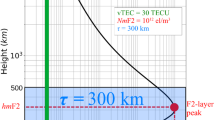Abstract
On the basis of previous work, we develop a middle and low latitude theoretical ionospheric model in this paper, named Theoretical Ionospheric Model of the Earth in the Institute of Geology and Geophysics, Chinese Academy of Sciences (TIME-IGGCAS). TIME-IGGCAS solves the equations of mass continuity, motion and energy of electron and ions self-consistently and uses an eccentric dipole field approximation to the Earth’s magnetic field. We combine the Eulerian and Lagrangian approaches in the model and take account of the plasma E×B drift velocity. Calculation results reveal that the model is steady and credible and can reproduce most large-scale features of ionosphere. By using TIME-IGGCAS, we carried out an observation system data assimilation experiment. Assimilation results show that the E×B drift velocity can be accurately estimated by ingesting the observed foF2 and hmF2 into the model applying nonlinear least-square fit method. We suggest that this work is of great significance in the development of ionospheric data assimilation model to give better nowcast and forecast of ionosphere.
Similar content being viewed by others
References
Roble R G, Ridley E C, Richmond A D, et al. A coupled thermosphere and ionosphere general circulation model. Geophys Res Lett, 1988, 15: 1325–1328
Richards P G, Torr D G. Seasonal, diurnal, and solar cyclical variations of the limiting H+ flux in the Earth’s topside ionosphere. J Geophys Res, 1985, 90: 5291–5268
Bailey G J, Balan N, Su Y Z. The Sheffield University plasmasphere ionosphere model—A review. J Atmos Solar-Terr Phys, 1997, 59: 1541–1552
Millward G H. A global model of the earth’s thermosphere, ionosphere and plasmasphere: theoretical studies of the response to enhanced high-latitude convection. Dissertation for the Doctoral Degree. UK: University of Sheffield, 1993. 1–195
Anderson D N. A theoretical study of the ionospheric F region equatorial anomaly, I. Theory. Planet Space Sci, 1973, 21: 409–419
Huba J D, Joyce G, Fedder J A. Sami2 is another model of the ionosphere (SAMI2): A new low latitude ionospheric model. J Geophys Res, 2000, 105(A10): 23035–23053
Pavlov A V. New method in computer simulations of electron and ion densities and temperatures in the plasmasphere and low-latitude ionosphere. Ann Geophys, 2003, 21: 1601–1628
Tu J N, Liu L B, Bao Z T. A low latitude theoretical ionospheric model. Chin J Space Sci (in Chinese), 1997, 17: 212–219
Liu L B, Wan W X, Tu J N, et al. Modeling of the ionospheric response to the solar eclipse of 24 October 1995. Terr Atmos Ocean Sci, 2000, 11(2): 543–554
Liu L B, Wan W X. The Evolution of Equatorial Trough of Ionospheric F-region Ionization. Terr Atmos Ocean Sci, 2001, 12(3): 559–565
Zhang S R, Huang X Y. An ionospheric numerical model and some results for the electron density structure below the F2 peak. Adv Space Res, 1995, 16(5): 119–120
Gao M, Xiao Z. An ionospheric physical model and its application in the investigation of the formation F1 valley region. Chin J Space Sci (in Chinese), 1992, 12(4): 287–297
Wang J S, Xiao Z. Time dependent ionospheric model in the meridian plane and its boundary conditions. Chin J Geophys (in Chinese), 1999, 42(1): 18–29
Zhang M L, Radicella, S M, Shang S P. A physical numerical ionospheric model and its simulation results. Commun Theor Phys, 2004, 41: 795–800
Zhang B C, Kamide Y, Liu R Y. Response of electron temperature to field-aligned current carried by thermal electrons: A model. J Geophys Res, 2003, 108(A5): 1169–1179
Zhu M H, Taieb C, Cao C. Middle latitude ionospheric model investigation. Chin J Space Sci (in Chinese), 1998, 18: 23–30
Lei J H, Liu L, Wan W, et al. Model results for the ionospheric lower transition height over mid-latitude. Ann Geophys, 2004, 22: 2037–2045
Wang C, Hajj G, Pi X, Rosen I G, et al. Development of the Global Assimilative Ionospheric Model. Radio Sci, 2004, 39: RS1S06, doi:10.1029/2002RS002854
Schunk R W, Scherliess L, Sojka J J, et al. Global Assimilation of Ionospheric Measurements (GAIM). Radio Sci, 2004, 39: RS1S02, doi:10.1029/2002RS002794
Zhang S R, Oliver W L, Fukao S, et al. Extraction of solar and thermospheric information from the ionospheric electron density profile. J Geophys Res, 2001, 106: 12821–12836
Zhang S R, Oliver W L, Holt J M, et al. Solar EUV flux, exospheric temperature and thermospheric wind inferred from incoherent scatter measurements of electron density profile at Millstone and Shigaraki. Geophys Res Lett, 2002, 29(9): 1207–1210
Lei J H, Liu L, Wan W, et al. Modeling investigation of ionospheric storm effects over Millstone Hill during August 4–5, 1992. Earth Planet Space, 2004, 56(9): 903–908
Lei J H. Statistical analysis and modeling investigation of middle latitude ionosphere. Dissertation for the Doctoral Degree. Beijing: Institute of Geology and Geophysics, Chinese Academy of Sciences, 2005. 48–68
Scherliess L, Fejer B G. Radar and satellite global equatorial F region vertical drift model. J Geophys Res, 1999, 104(A4): 6829–6842
Rishbeth H. How the thermospheric circulation affects the ionosphere F2-layer. J Atmos Terr Phys, 1998, 60: 1385–1402
Zhao B Q. Annual anomaly and storm features of middle and low latitude ionosphere investigations. Dissertation for the Doctoral Degree. Beijing: Institute of Geology and Geophysics, Chinese Academy of Sciences, 2006. 37–67
Pi X, Wang C, Hajj G A, et al. Estimation of E×B drift using a global assimilative ionospheric model: An observation system simulation experiment. J Geophys Res, 2003, 108(A2): 1075–1088
Lei J, Liu L, Wan W, et al. Modeling the behavior of ionosphere above Millstone Hill during the September 21–27, 1998 storm. J Atmos Solar-Terr Phys, 2004, 66: 1093–1102
Author information
Authors and Affiliations
Corresponding author
Additional information
Supported by the Knowledge Innovation Project of Chinese Academy of Sciences (Grant No. KZCX3-SW-144), the National Natural Science Foundation of China (Grant Nos. 40636032, 40574071 and 40504023), and National Important Basic Research Project (Grant No. 2006CB806306)
About this article
Cite this article
Yue, X., Wan, W., Liu, L. et al. Development of a middle and low latitude theoretical ionospheric model and an observation system data assimilation experiment. Chin. Sci. Bull. 53, 94–101 (2008). https://doi.org/10.1007/s11434-007-0462-z
Received:
Accepted:
Issue Date:
DOI: https://doi.org/10.1007/s11434-007-0462-z




